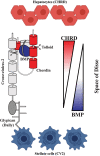The developmental gene Chordin is amplified and expressed in human cancers
- PMID: 37260544
- PMCID: PMC10228393
- DOI: 10.1080/23723556.2023.2218147
The developmental gene Chordin is amplified and expressed in human cancers
Abstract
Chordin (CHRD) is a secreted protein important in early development, yet a role for CHRD in human disease has not been identified. In this study we investigated CHRD in cancer and normal adult tissues using the wealth of genome-wide data available in public databases. We found that Chordin is amplified in the DNA of specific cancers such as lung squamous cell and others, although copy number variation did not strictly correlate with higher mRNA expression. In some cancers, such as renal and stomach carcinomas, increased CHRD expression significantly correlated with poor survival. In normal adult human tissues, CHRD mRNA was highest in hepatocytes. Crossveinless-2/BMPER, a component of the Chordin morphogenetic pathway expressed at the opposite side in embryos, was expressed in liver stellate cells. This raises the intriguing possibility that a BMP gradient might be established in the extracellular matrix of the space of Disse that surrounds portal sinusoid capillaries.
Keywords: Bone morphogenetic proteins; Chordin; Crossveinless 2; TCGA; hepatocytes; lung squamous cell carcinoma; renal carcinoma; scRNA-seq; stellate cells; stomach carcinoma.
© 2023 The Author(s). Published with license by Taylor & Francis Group, LLC.
Conflict of interest statement
No potential conflict of interest was reported by the author(s).
Figures




Similar articles
-
Coding sequence and expression patterns of mouse chordin and mapping of the cognate mouse chrd and human CHRD genes.Genomics. 1998 Sep 1;52(2):236-9. doi: 10.1006/geno.1998.5474. Genomics. 1998. PMID: 9782094
-
The human chordin gene encodes several differentially expressed spliced variants with distinct BMP opposing activities.Mech Dev. 2001 Aug;106(1-2):85-96. doi: 10.1016/s0925-4773(01)00423-3. Mech Dev. 2001. PMID: 11472837
-
Chordin is underexpressed in ovarian tumors and reduces tumor cell motility.FASEB J. 2006 Feb;20(2):240-50. doi: 10.1096/fj.05-4126com. FASEB J. 2006. PMID: 16449796
-
The Chordin Morphogenetic Pathway.Curr Top Dev Biol. 2016;116:231-45. doi: 10.1016/bs.ctdb.2015.10.003. Epub 2016 Jan 7. Curr Top Dev Biol. 2016. PMID: 26970622 Review.
-
CHRD, a novel domain in the BMP inhibitor chordin, is also found in microbial proteins.Trends Biochem Sci. 2003 Sep;28(9):470-3. doi: 10.1016/S0968-0004(03)00171-3. Trends Biochem Sci. 2003. PMID: 13678956 Review.
Cited by
-
BMP signalling in colorectal cancer: losing the yin to WNTs yang.J Pathol. 2025 Jul;266(3):280-291. doi: 10.1002/path.6428. Epub 2025 Apr 11. J Pathol. 2025. PMID: 40212011 Free PMC article. Review.
-
Exploration of Toxins from a Marine Annelid: An Analysis of Phyllotoxins and Accompanying Bioactives.Animals (Basel). 2024 Feb 16;14(4):635. doi: 10.3390/ani14040635. Animals (Basel). 2024. PMID: 38396603 Free PMC article.
